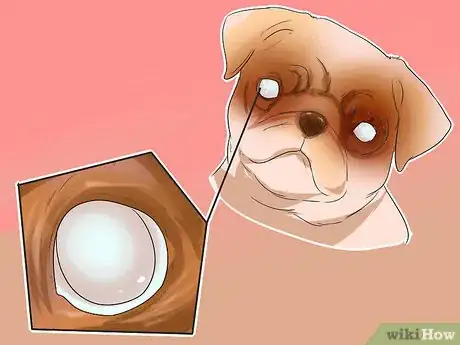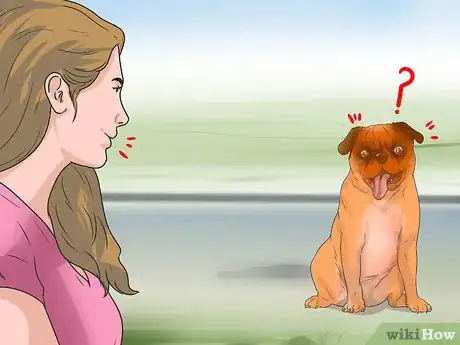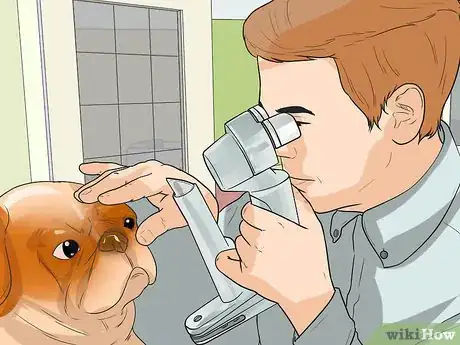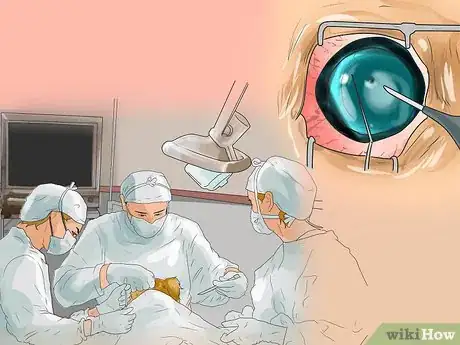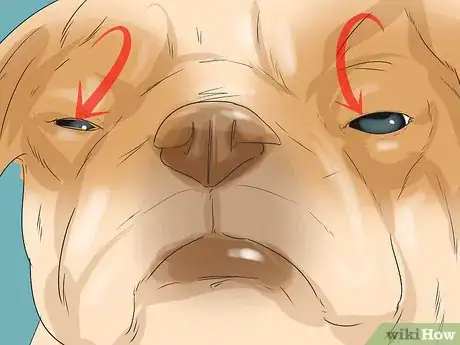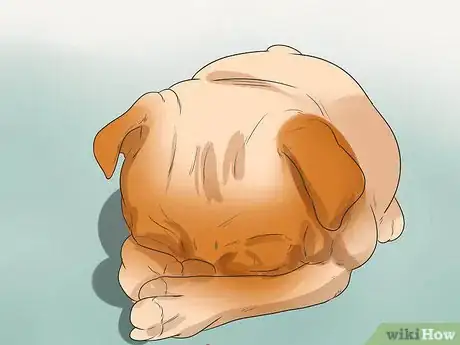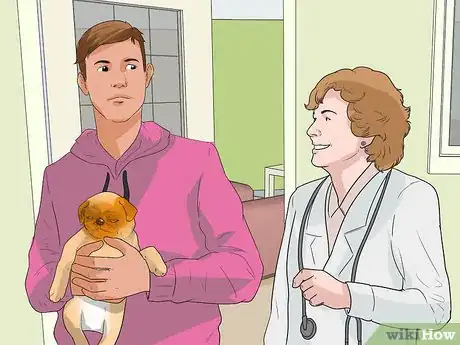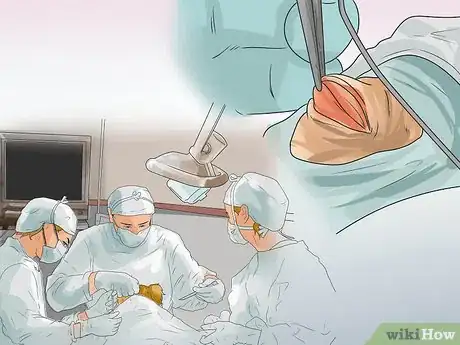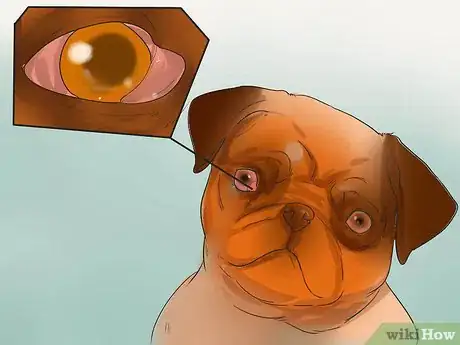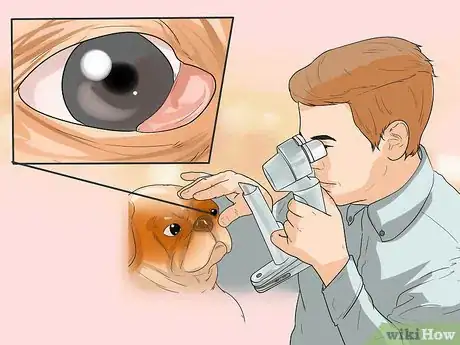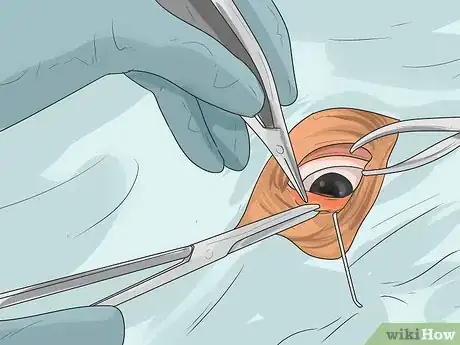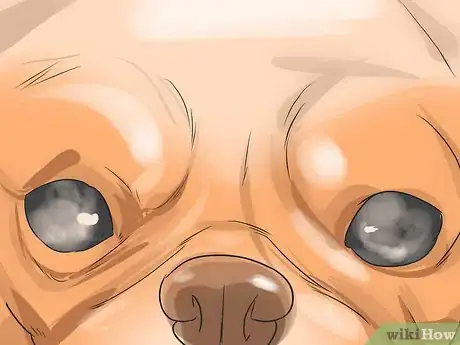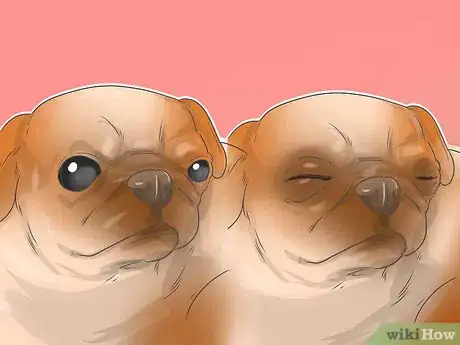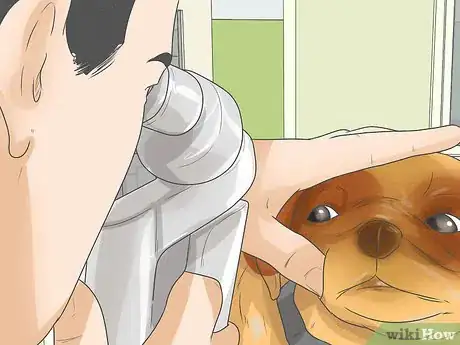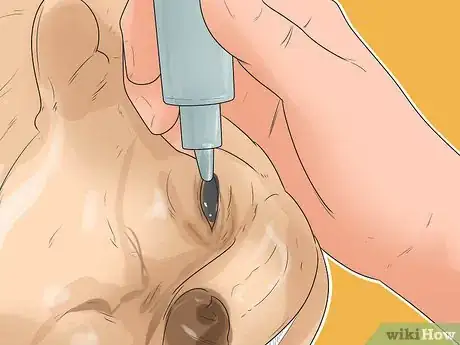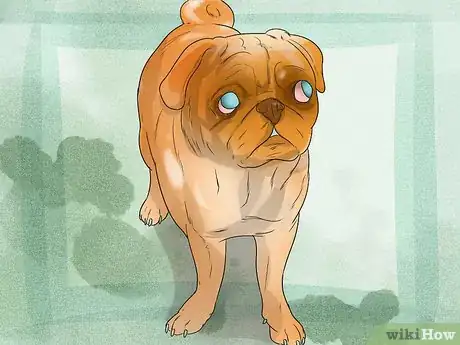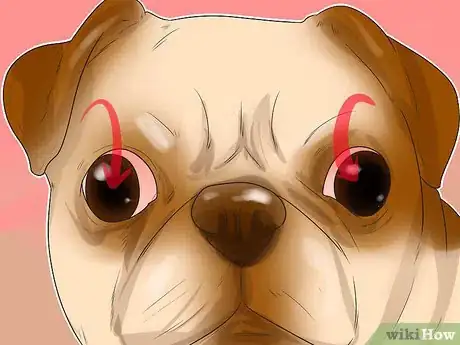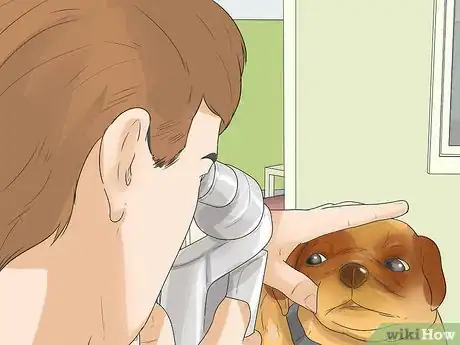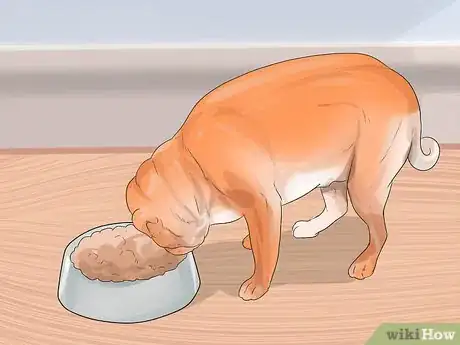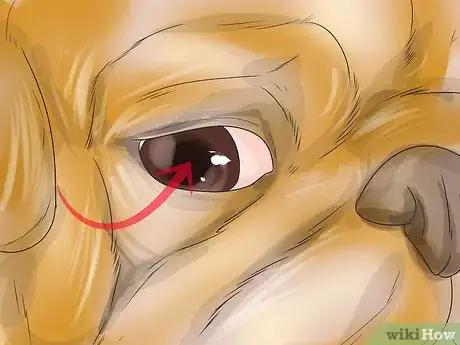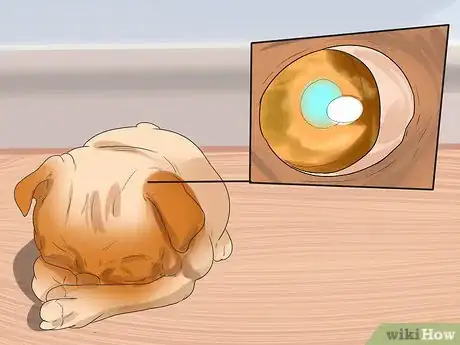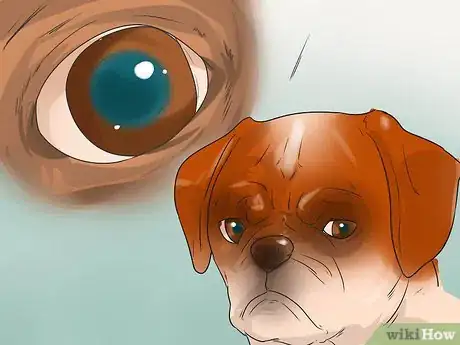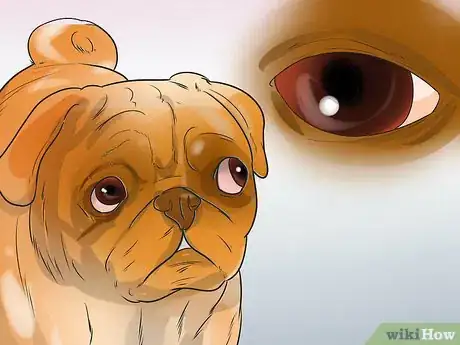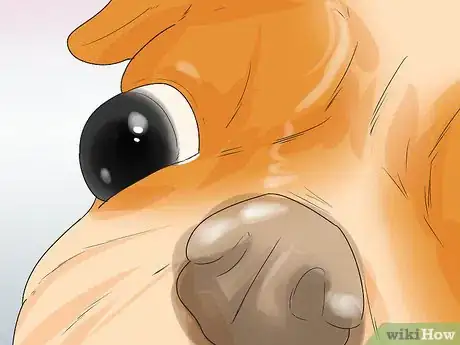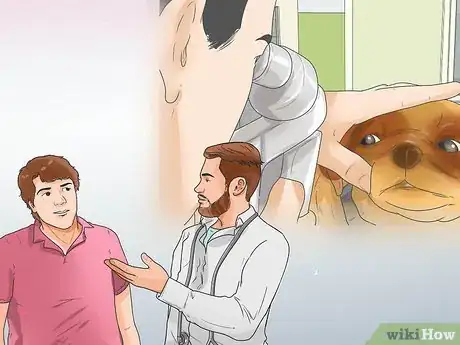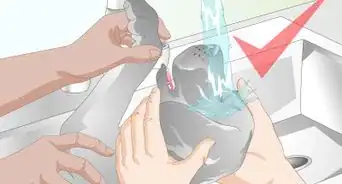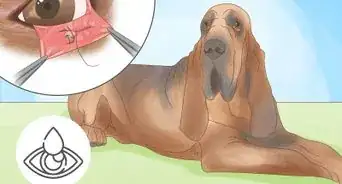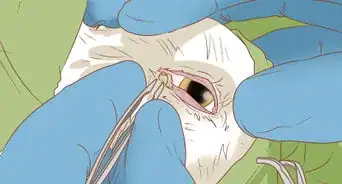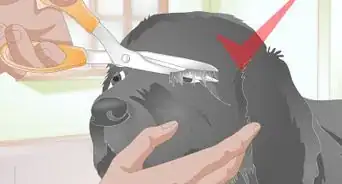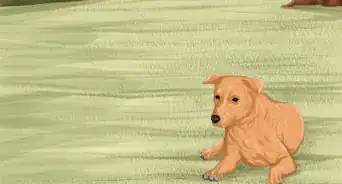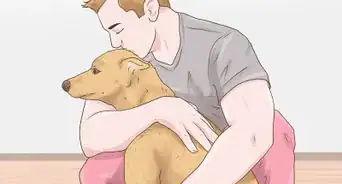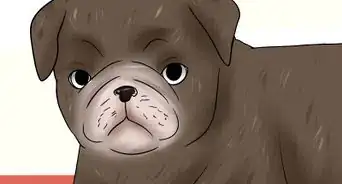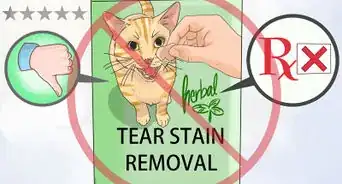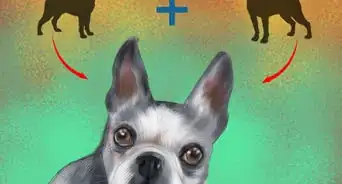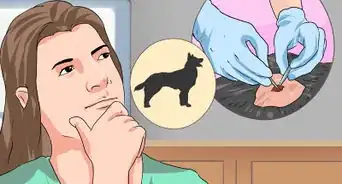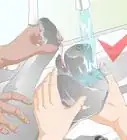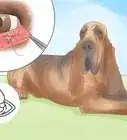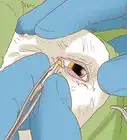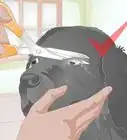This article was co-authored by Pippa Elliott, MRCVS and by wikiHow staff writer, Jessica Gibson. Dr. Elliott, BVMS, MRCVS is a veterinarian with over 30 years of experience in veterinary surgery and companion animal practice. She graduated from the University of Glasgow in 1987 with a degree in veterinary medicine and surgery. She has worked at the same animal clinic in her hometown for over 20 years.
There are 11 references cited in this article, which can be found at the bottom of the page.
This article has been viewed 47,818 times.
Pugs are adorable little dogs with big personalities and large eyes. But these recognizable large eyes can develop a variety of problems. While not all pugs develop eye problems, they are prone to developing cataracts, cherry eye, dry eye, and other issues. Since the signs of several eye problems are so similar, remember that it's important to take your pug to the vet for a diagnosis and proper treatment.
Steps
Recognizing and Treating Cataracts
-
1Watch for milky eyes. The lens of your pug's eye might seem cloudy and bluish-gray. Eventually, the cataract covering the lens can cause your dog to lose his vision. The cataract might look crackly or like a chip of ice.
- Cataracts form either due to genetic predisposition, trauma, diabetes or other diseases.
-
2Pay attention to your dog's behavior. If a cataract is covering your dog's eye, she may have trouble seeing. As a result, she may be clumsier and less sure of her surroundings. You may also notice your dog:
- Bumping into things.
- Not recognizing people.
- Misjudging distances.
Advertisement -
3Get your pug examined. Make an appointment with the veterinarian as soon as you notice the milky eyes. The vet can usually diagnose cataracts simply by looking at your dog's eyes and a veterinary surgeon can confirm the diagnosis.[1]
- If your dog his older, his lens may simply be aging but it shouldn't affect his vision too much. The vet will check for this.
-
4Get surgery for cataracts. Cataracts in the early stages may make her vision blurry, but a mature cataract will cause blindness, so you might want to surgically remove it. During surgery a specialist surgeon will remove the lens and replace it with an artificial one. Or, the cataract can be broken down by a laser in a procedure known as phacoemulsification.
- If you want your pug to get surgery, it's important to do it before your dog's vision worsens.
Recognizing and Treating Entropion
-
1Check your pug's eyelids. If you see your dog's eyelid is rolled up and inward, he probably has a condition called entropion. The eyelid rubs directly against your pug's eye and can scratch or irritate the cornea. If your dog has had untreated entropion for a while, his eye might look milky or blue from scar tissue that develops over the eye.[2]
- The eye may also swell up if the eyelashes are scratching against your dog's eyeball.
-
2Look for signs of irritation. Your pug may seem bothered by something in her eye. You might notice her rubbing her eyes or squinting a lot. Since eyelashes from the rolled out eyelid are rubbing against her cornea, her eyes may water a lot. Your dog might also blink a lot or try to hold her eyes closed.
- Entropion is painful. If you suspect at all that your pug is in pain because of something in her eye, you should take her to the vet.
-
3Get your pug diagnosed. The vet will carefully look at your pug's eyes to see if they're symmetrical. The vet will also look inside your pug's eyes and will look at the cornea under magnification to see if eyelashes are rubbing. If the vet can apply pressure to the eye and the eyelid rolls into place but pops back when pressure is released, your pug has entropion.[3]
- A veterinary ophthalmologist may also be asked to examine the eyes.
-
4Get surgery. A veterinary surgeon will remove a little of the tissue underneath your pug's eye. This can help the eyelid sit correctly and keep it from rubbing against the cornea. Or, if your pug is young, the vet may recommend tacking the eyelid above or below the lid so that the eyelid develops correctly as the pug grows.[4]
- Surgery to treat entropion can be expensive.
Recognizing and Treating Cherry Eye
-
1Look for redness and swelling. Pugs are one of the breeds that have a third eyelid. This sits on the inner part of the eye where it travels across the cornea in order to protect it. The eye is lubricated by tear fluid that comes from a gland in the third eye. If a gland on the third eye pops forward, you'll notice that a large round mass swells to cover the inner part of the eye.[5]
- This red swollen mass often looks like a cherry.
-
2Get a medical examination. Most pugs aren't bothered by cherry eye, which is largely a cosmetic issue. But, if your dog seems to be bothered by it or if you aren't sure if he actually has cherry eye, you should get a veterinarian's diagnosis. Your dog may have a different eye condition if he seems to be in pain.[6]
- It's thought that the glands in a pug's eyes can pop forward when connective tissue around the glands weaken, although vets aren't exactly sure what causes cherry eye.
-
3Get surgery. You can decide whether or not to remove the cherry eye through surgery. If you do want it removed, the veterinary surgeon will place the gland back into the right place and stitch it so it doesn't pop out. The surgery is done under anesthesia.[7]
- If you don't want to do surgery, you can ignore the cherry eye (unless your dog becomes bothered by it) or try steroid ointments.
Recognizing and Treating Dry Eye
-
1See if your pug's eyes are dry. Your dog's eyes may look dull, irritated and red. If your dog has keratoconjunctivitis sicca, also known as dry eye, her eyes aren't making enough natural tear fluid. A thick, sticky discharge can also keep seeping from the eyes.[8] [9]
- Pugs are one breed that are likely to develop dry eyes which are also more common in middle-aged to older dogs.
-
2
-
3Get your pug examined. Since dry eyes can become infected, your dog will need medical care. During an exam, the vet will examine your dog's eyes and test for tear production. The vet will insert a special paper into the corner of your dog's eye. This will show how much tear film your dog makes in one minute and the vet will use the results to make a diagnosis.[12]
- Other things could be causing the inflammation, like glaucoma or corneal ulcers so the vet will check for those conditions as well.
-
4Use eye drops or prescription medication. Your dog will need over-the-counter eye drops or prescription medication to lubricate the eyes. Follow the dosing instructions. But, you'll probably need to apply watery artificial tears every hour or four to six times a day if you're using thicker drops. Some medications only need a few applications a day.[13]
- The vet will probably have you cut back on using medication after your dog's eyes are producing tears again. But, since dry eye is a chronic condition, your dog will probably need to use some lubricant for life.
Recognizing and Managing Progressive Retinal Atrophy
-
1Monitor your dog's night vision. Pay attention to how your dog functions in low lighting. If you see her unsure of or bumping into her surroundings, she may be having trouble seeing in the dark. Night blindness is a sign of Progressive Retinal Atrophy (PRA).[14]
- PRA isn't painful so you won't see your pug rubbing her eyes, squinting, or tearing up. Instead, you'll see a gradual worsening of her vision during the day which could develop into complete blindness.
-
2Look for changes in your pug's eyes. Some pug owners say that they noticed their pug's eyes were shiny because of PRA. Another sign of PRA is abnormal pupil reactions or dilation. Your dog's pupils may always appear dilated because his eyes are trying to let in more light to compensate for his lack of vision.[15]
- You can try shining a light in your pug's eyes to see how his eyes react. Normally, his pupils should become smaller as you shine the light and they should get larger when you remove the light.
-
3Get your dog examined. The vet will take a full family history of your dog's health. Since PRA is an inherited disease, it's important to find if your dog is genetically predisposed to developing the disease. The vet will also examine the inside of your dog's eye using a slit lamp to check for any abnormalities with the retinas.[16]
- The vet will also do blood work and test your pug's urine to check for any other conditions.
-
4Help your dog cope with PRA. Unfortunately, there are no medications or surgeries to treat PRA. You may be able slow down the loss of vision by improving your dog's diet (if the PRA was caused by a metabolic condition). Otherwise, you'll need to watch out for your pug to make sure she's safe from injury or attack. Take her to the vet for regular eye examinations which could detect cataracts or glaucoma that develop. Remember, your dog isn't in pain.[17]
- To modify your dog's diet, change your pug's diet to a low-fat omnivorous diet (includes meat).
- If your pug has PRA, avoid breeding her since the disease is genetically spread.
Recognizing and Treating Other Eye Problems
-
1Treat corneal ulcers. Look for squinting, thick eye discharge, watering, or eye redness. Your pug may act like he's in pain. This is because your dog's cornea is large and can easily become scratched or injured. This kind of trauma can cause ulcers that may become infected.[18]
- To treat ulcers, the vet will examine the eye and test for infection. Depending on the cause of the ulcer, your pug may need surgery, topical medications, or contact lenses (instead of surgery).
-
2Watch for Exposure Keratopathy Syndrome (EKS). EKS shares many of the same signs as corneal ulcers. Your dog will appear to be in pain, may rub her eye with her paws, have more tears, and red eyes. If your dog has EKS, she won't be able to fully close her eyes (even when she sleeps). This can cause damage to the cornea since it will dry out.
- To treat EKS, your veterinarian will probably recommend surgery to improve the eyelid. In the meantime, your pug will probably need lubricating drops to prevent damage to the cornea.
-
3Check your pug's eyes for distichiasis. Again, your dog's eyes might seem red, irritated, watery, or you may see a thick discharge. Your pug may appear bothered by something in his eye. He may have distichiasis, a condition where eyelashes grow in gland ducts of the eye where normally eyelashes don’t grow. The eyelashes can scratch and irritate the eyeball.
- Your vet may treat distichiasis by surgically destroying the hair follicles so the eyelashes can't grow back. If your dog only has minor irritation, the vet can recommend an eye ointment to keep the eye lubricated.
-
4Look at the eyes for keratitis. If you look at your pug's eye and see abnormal brown spots or a grayish haze covering the cornea, she may have a type of keratitis. Trauma to the eye can cause pigmentary keratitis which makes the brown spots. Pannus or chronic superficial keratitis can cause the grayish haze when blood vessels and tissue grows on the eye. Pannus keratitis is an immune response that causes eye inflammation.
- Since keratitis can cause loss of vision, it's important to get medical treatment. To treat keratitis, your pug will probably need topical steroids or anti-inflammatory eye drops for the rest of her life.
-
5Watch for bulging of the eye (proptosis). If your pug experiences trauma around the head or too much pressure is placed on the neck, his eyes may literally bulge out of the sockets. If you see this, get emergency veterinary treatment since it's painful. The veterinarian may try to lubricate the eye and gently push it back into place while your dog is under anesthesia. Or, the veterinarian may recommend surgically removing the eye.[19]
- Never grab a pug around the neck or you may cause proptosis. Use a harness instead of a collar when walking your pug.
-
6Get your pug examined. Check your pug every day for any signs of eye problems. If you notice anything unusual or have any questions about a potential eye problem, contact your veterinarian as soon as possible. Early eye treatment could prevent serious damage to the eye.
- Follow through with the veterinarian's orders. This means giving all medications as prescribed by your veterinarian. Do not discontinue a medication without consulting your veterinarian.
References
- ↑ http://www.ufaw.org.uk/dogs/boston-terrier---hereditary-cataract
- ↑ http://www.embracepetinsurance.com/health/entropion
- ↑ http://www.embracepetinsurance.com/health/entropion
- ↑ http://www.embracepetinsurance.com/health/entropion
- ↑ http://www.animalplanet.com/pets/healthy-pets/dog-eye-disorders/
- ↑ http://www.animalplanet.com/pets/healthy-pets/dog-eye-disorders/
- ↑ https://www.cesarsway.com/dog-care/eye-care/cherry-eye
- ↑ http://www.vcahospitals.com/main/pet-health-information/article/animal-health/keratoconjunctivitis-sicca-kcs-or-dry-eye-in-dogs/825
- ↑ https://todaysveterinarypractice.com/diagnosis-treatment-of-keratoconjunctivitis-sicca-in-dogs/
- ↑ http://www.vcahospitals.com/main/pet-health-information/article/animal-health/keratoconjunctivitis-sicca-kcs-or-dry-eye-in-dogs/825
- ↑ http://www.peteducation.com/article.cfm?c=2+2092&aid=451
- ↑ http://www.vcahospitals.com/main/pet-health-information/article/animal-health/keratoconjunctivitis-sicca-kcs-or-dry-eye-in-dogs/825
- ↑ http://www.vcahospitals.com/main/pet-health-information/article/animal-health/keratoconjunctivitis-sicca-kcs-or-dry-eye-in-dogs/825
- ↑ http://www.petmd.com/dog/conditions/eyes/c_dg_retinal_degeneration
- ↑ http://www.petmd.com/dog/conditions/eyes/c_dg_retinal_degeneration
- ↑ http://www.petmd.com/dog/conditions/eyes/c_dg_retinal_degeneration
- ↑ http://www.petmd.com/dog/conditions/eyes/c_dg_retinal_degeneration?page=2
- ↑ http://www.petmd.com/dog/conditions/eyes/c_dg_Keratitis_Ulcerative?page=2
- ↑ http://www.petplace.com/article/dogs/diseases-conditions-of-dogs/eyes/eye-proptosis-in-dogs
About This Article
To treat eye problems in pugs, take your pug to the vet if you notice that its eyes are milky, red, swollen, dry, or irritated. Then, once the vet examines your pug's eyes and diagnoses the issue, follow their recommended treatment plan, which may include eye drops, medication, or surgery. Keep in mind that pugs can develop a variety of eye problems, like dry eyes, cataracts, and ulcers, so it's important that you get a proper diagnosis before you try to treat the issue. For more tips from our Veterinary co-author, like how to recognize common eye problems in pugs, read on!
